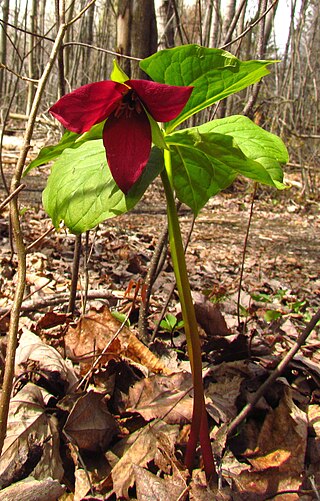
Trillium erectum, the red trillium, also known as wake robin, purple trillium, bethroot, or stinking benjamin, is a species of flowering plant in the family Melanthiaceae. The plant takes its common name "wake robin" by analogy with the European robin, which has a red breast heralding spring. Likewise Trillium erectum is a spring ephemeral plant whose life-cycle is synchronized with that of the forests in which it lives. It is native to the eastern United States and eastern Canada from northern Georgia to Quebec and New Brunswick.
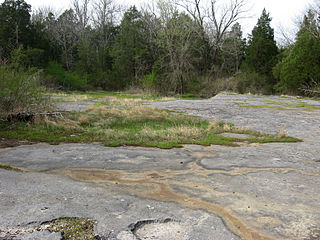
A calcareous glade is a type of ecological community that is found in the central Eastern United States. Calcareous glades occur where bedrock such as limestone occurs near or at the surface, and have very shallow and little soil development. Due to the shallow soil and the extreme conditions created by it, trees are often unable to grow in the glades. This creates a habitat that is usually sunny, dry, and hot. Calcareous glade vegetation is more similar to that of a desert habitat than a grassland, being dominated by small spring annuals with occasional geophytic or succulent perennials.

Clintonia uniflora, commonly known as bride's bonnet, queen's cup, or bead lily, is a species of flowering plant in the lily family Liliaceae. The specific epithet uniflora means "one-flowered", a characteristic that distinguishes this species from others in the genus Clintonia. For this reason, it is also known as the single-flowered clintonia.

Ericameria laricifolia is a North American species of flowering shrub in the family Asteraceae known by the common name turpentine bush, or turpentine-brush. It is native to the southwestern United States and northern Mexico (Chihuahua).
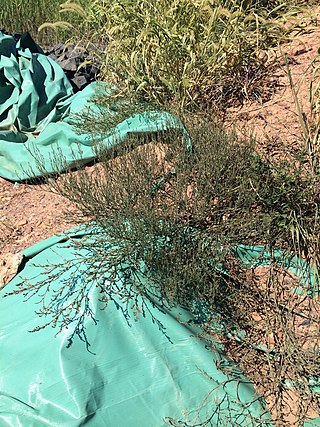
Polygonum ramosissimum is a North American species of herbaceous annual plants in the buckwheat family, widespread across much of Canada and the United States, where it is commonly called bushy knotweed. It is susceptible to downy mildew caused by the oomycete species Peronospora americana.

Helianthus grosseserratus, commonly known as sawtooth sunflower or thick-tooth sunflower, is a perennial sunflower in the family Asteraceae, with a large flowering head (inflorescence).
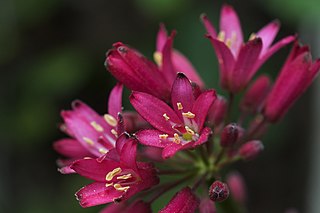
Clintonia andrewsiana is a species of flowering plant in the lily family Liliaceae. The species was discovered by John Milton Bigelow in 1854 and described by John Torrey in 1856. The specific epithet andrewsiana honors Timothy Langdon Andrews (1819–1908), a "gentleman who assiduously examined the botany" of California during the mid-19th century. The species is commonly known as Andrews clintonia or red clintonia, where the latter refers to the color of the flowers. In California, it is also known as bluebead lily or western bluebead lily, not to be confused with C. borealis, which is likewise known as bluebead lily. The Pomo people of northern California considered the plant to be poisonous.

Nothocalais troximoides is a species of flowering plant in the family Asteraceae known by the common name sagebrush false dandelion. It is native to western North America, including British Columbia and the northwestern United States.

Solidago missouriensis is a species of flowering plant in the family Asteraceae known by the common names Missouri goldenrod and prairie goldenrod. It is native to North America, where it is widespread across much of Canada, the United States, and northern Mexico. It grows from British Columbia east to Manitoba, south as far as Sonora, Coahuila, Texas, and Mississippi.

Leavenworthia is a genus of flowering plants in the family Brassicaceae. It includes about eight species native to the southern and southeastern United States. They are known generally as gladecresses.

Sagittaria australis, the Appalachian arrowhead or longbeak arrowhead, is a plant species native to much of the eastern part of the United States, from Louisiana to Iowa to New York State to Florida, mostly between New Jersey and Mississippi with scattered locations elsewhere in the range.
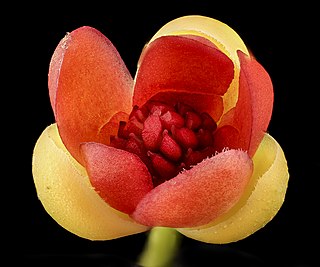
Schisandra glabra, the bay star-vine, is the only American species of this primarily Asian genus. It is native to the southeastern United States and northern Mexico. It grows in Louisiana, eastern Arkansas, southwestern Tennessee, Mississippi, Alabama, northwestern Florida, and Georgia, with isolated populations in Kentucky, South Carolina, North Carolina, and Hidalgo. Despite its wide range, it is considered a vulnerable species. Few populations are secure due to competition from invasive species and habitat loss.

Portulaca suffrutescens, the shrubby purslane, is a plant species native to the southwestern United States and northern and central Mexico. It has been found in Arizona, New Mexico, Texas, Sonora, Chihuahua, Sinaloa, Durango, Querétaro and Guerrero.
Descurainia paradisa is a plant species native to eastern and northern California, southeastern Oregon, Box Elder County in northwestern Utah, and most of Nevada. It grows in shrub communities at elevations of 3,300–7,500 feet (1,000–2,300 m).

Lyonia fruticosa, the poor-grub or coastal plain staggerbush, is a plant species native to the US states of Florida, southern Georgia and the extreme southern part of South Carolina. It grows in pine woodlands and shrub bogs at elevations less than 100 meters.

Allium tolmiei is a plant species native to Idaho, eastern and central Oregon, southeastern Washington, northwestern Nevada and northeastern California. It occurs on mountains and scrublands at elevations of 1,300–9,200 feet (400–2,800 m). It was discovered by and named for Dr. William Fraser Tolmie.

Sagittaria graminea, the grassy arrowhead or grass-leaved arrowhead, is an aquatic plant species native to eastern North America.

Quercus similis, the swamp post oak or bottomland post oak, is an oak species native to the southeastern and south-central United States. The greatest concentration of populations is in Louisiana and Arkansas, Mississippi, and eastern Texas, with isolated population in Missouri, Alabama, and the Coastal Plain of Georgia and South Carolina.

Elephantopus carolinianus, with the common names Carolina elephantsfoot or leafy elephant's foot, is a species of flowering plant in the Asteraceae family. It is native to the south-central and southeastern United States.
Erigeron lobatus is a rare species of flowering plant in the family Asteraceae known by the common name lobed fleabane. It has been found the state of Sonora in northwestern Mexico as well as in the southwestern United States.


















